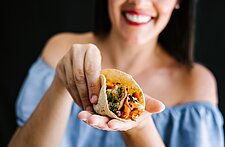At the beginning of the COVID-19 pandemic, grocery sales rose across almost all categories due to stockpiling and panic shopping. Frozen foods sales increased dramatically as adults assumed the worst and made sure their households would not have to worry about running out of food for what was first assumed to be weeks that quickly turned into months of quarantine restrictions. These sales are not sustainable, however, as the longevity of frozen meals works against their continued purchase. That, along with a public seeking healthier, budget-friendly options post-pandemic, creates new challenges but also exciting opportunities for the frozen sector’s sales in the next five years.
Stay ahead of the changing industry with In-sight, learn more here!
Opportunities and Silver Linings
As the pandemic began in March there was a rise in frozen foods sales, especially for appetizers and handheld entrees, as seen in previous recessions. Recessions aren’t created equal, however; unemployment was more drastic and sudden in 2020 with numbers more than tripling in one month than in the Great Recession starting in 2007 which had a steady rise in unemployment over a few years. This recession added an extra element of panic buying for fear of sudden income loss, drop in socializing, and foodservice shutting down immediately, giving families few options if they run out of food.
From the start of the pandemic in March through June, sales of frozen snacks saw a strong surge due to lockdown stockpile shopping. Sales started to decline in July which is projected to continue until December 2021 as consumers stop stockpiling and are content with the amount of frozen goods in their freezer. According to a report by Mintel, the frozen food category saw an 8.3% positive change in 2020 and is projected to have a 3.5% drop in 2021 as pandemic fears lessen.
Within sales, price was more of a factor than brand loyalty or awareness due to the heightened fear of job loss and shopping with the intent of quantity over familiar brand. Mintel reported that six in 10 polled adults 18+ reported that price is more important to them while shopping than brand. Depending on additional lockdowns, however, the frozen snack sector could have the opportunity to benefit and capitalize on sales if another widespread lockdown occurs and reignites stockpile shopping behaviors. If not, sales are projected to return to a pre-COVID amount in 2022-2025 as all categories readjust back to normal shopping habits over the next five years.
Over the next few years, the frozen food sector can take the opportunity to push convenience and budget-friendly cost as adult consumers reevaluate budgets as unemployment slowly returns to pre-COVID averages and choose more, lower-cost food items to fit a smaller food shopping budget. Brands can also benefit from nostalgia and the need for indulgence, especially in snacks which have seen gains year over year despite the pandemic. Consumers are looking for something quick, comfortable, and familiar during a time where their options for going out are limited, so reaching into the freezer for something indulgent and reminds them of childhood is an ideal. Mintel found that 71% of U.S. consumers enjoy things that remind them of their past, and this trend can play a role in purchase behavior. Even prior to the pandemic, Mintel found this to be a big driver for frozen snacks in adult buyers, but this has only increased during uncertain times when a snack can provide more comfort than normal.
 New Challenges for Years to Come
New Challenges for Years to Come
Frozen snacks and meals have always been most popular with families and households with children, but a long-term issue the sector will need to tackle once pandemic purchasing is over is the fact that the number of households with children is shrinking and a third of these households with children, and even more without children, are looking for healthier snack options and don’t buy from the category at all.
As the population becomes more health-conscious as the pandemic makes families take a hard look at their shopping choices moving forward, consumers are moving away from standard “diet” frozen foods marketing themselves as leaner and healthier without the ingredients to back up that claim. Labeling a food as “healthy” no longer means just low calorie or low fat; consumer are looking for ingredients and meals with beneficial effects, especially immune boosting during a viral pandemic.
RELATED: [Infographic] Mainstream Flavor Trends Surfacing From COVID-19
The biggest benefit of these meals before were that they were fast and required no prep for busy working adults. People still want the easy, after-work option for family meals, but with many more adults working from home, “quick” isn’t as important as it was a year ago. The biggest challenge for the sector is getting these households to purchase again once their pandemic freezer stockpiles are gone through appealing to their need of healthier, less processed options.
As Gen Z is coming of age as consumers, shopping behaviors prior to the pandemic were mirroring those of their parents who raised them with healthier, less frozen foods. However, Gen Z in general is buying more frozen foods during the pandemic, but less indulgent meals and more within the health and wellness category as their choice of comfort. According to The Food Industry Association’s 2020 Grocery Shopper Report, 21% of both Gen Z and Millennials reported eating much healthier during the pandemic, while 27% report eating somewhat healthier. When the pandemic is over, the challenge for frozen food brands will be to keep this up-and-coming generation interested in remaining loyal to these products and not go back to pre-COVID habits as health and wellness stays top of mind for them and their Millennial parents. There is an opportunity to incorporate more ingredients and marketing that support what this generation is most concerned about in terms of health, especially functional and adaptogen ingredients and those supporting mental health.
What to Watch for in the Future
The pandemic has breathed new life into a category that has seen mostly stagnant growth performance over the last few years, with consumer interest shifting to less processed, natural and organic options. A return to normal shopping behaviors could mean a return to stagnate and decreased growth if brands do not shift focus to more natural takes on products to appeal to a new generation of shoppers who seek out authenticity in their food. Mintel found that 72% of polled childless adults and 78% of parents age 18+ wish there were more healthier foods that used healthier ingredients, and 45% of non-parents and 57% of parents said they would be willing to pay more of frozen snacks with organic ingredients. Consumers will continue to be attracted to private label meal options as well as turn to the next best, safer thing to going to restaurants: purchasing restaurant-branded frozen snacks to bring a little bit of that dine-in experience to their homes.
Want to learn more about how food and beverage companies can succeed in this environment? Continue reading the latest on COVID-19 and the food and beverage industry:
• Foodservice Adaptations in the Age of COVID-19
• COVID-19: Center of the Store Report
• 10 Opportunity Areas for CPG and Retailers in a COVID-19 World
• Behind the Rise of Batch Cooking in 2020
• Chicken Consumption in the United States and the Influence of COVID-19






